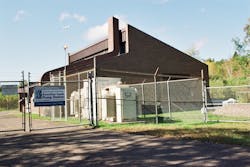While treating about 14 billion gallons of municipal and industrial sewage annually, WLSSD is committed to protecting the environment, including the region’s most precious resource: Lake Superior. Preventing sewer overflows and leaks into the watershed is a top priority; pump stations and force mains serve as an effective way to control sewer overflows.
Verifying Pipe Integrity Before a Big Price Tag
Because force mains are not accessible by camera, they can be notoriously difficult to evaluate. To help develop their asset management plan, WLSSD hired a consultant to evaluate their force mains to identify vulnerabilities in the network. The consultant conducted measurements and modeling on three force mains to identify the locations of greatest risk and recommended improvements to reduce that risk.
Based on this analysis, the consultant provided recommendations based on worst-case scenarios, ranging in cost from $185,000 to $1 million in capital improvements. Faced with this significant investment, WLSSD decided to obtain additional data to verify the model results prior to making capital improvements.
A WLSSD operator suggested using the Syrinix Pipeminder-C transient monitoring system, which he had seen at a conference. He noted the unit’s ability to measure high-resolution transients, down to an absolute vacuum (-14.50 psi gauge), and that it was also portable. The unit is a smart pressure monitor that measures continuously at 128 samples per second, and data is sent to a data hub, where it is analyzed against set performance parameters. This reveals the system’s operating state, which enables operators to quickly pinpoint issues that can be addressed to extend the life of the network.
Transient Monitoring Analysis of WLSSD
WLSSD installed the Pipeminder-C system in January 2020. Analyzing multiple locations, they found that the data generated during normal operations lined up reasonably well with the models, as expected. The pressure monitor enabled the WLSSD team to verify or identify specific problem areas, namely:
- A welded air release valve that was not providing benefit. The modeled data revealed this valve was providing limited air transfer to and from the pipe. The unit allowed WLSSD to confirm that this component was not critical to force main operation. The risk of an emergency repair from this connection will be eliminated without detriment to the operation of the system.
- An ineffective air release valve manhole. At one station, WLSSD had planned to vent an air release valve manhole to improve conditions. Data from the Pipeminder-C revealed that this change would not benefit pressures at the station or in the pipeline. This finding surprised the WLSSD team. Additional work is planned to evaluate whether reinstating a former air release valve location will improve pressures.
- Transient events due to power outages. The pressure monitor captured four significant transient events when the pumps shut down due to power failure. Transients were documented and showed significant additional pressure on the pipes that could cause a failure if continued. This data enabled the team to highlight the importance of determining the cause of the outages and to work with the utility to identify the cause and mitigate the problem.
What WLSSD Did With the Analysis
The information provided to WLSSD by the transient monitoring system resulted in the district saving costs with informed decisions, improved system ability and ease of use.
Informed decisions
WLSSD improved its ability to make decisions regarding capital investments and operations backed by accurate data. They now have the information needed to invest resources where there is the greatest risk and the greatest potential benefit.
Cost savings
Data provided by the Pipeminder-C now informs capital planning work to improve conditions of WLSSD’s force mains. While modeling is important, the results may not reflect actual conditions. Modeling that is too conservative can lead to unnecessary capital expenditures. Having accurate monitoring data helps WLSSD identify smaller capital projects that extend pipeline life, and to see where additional protection is not warranted.
Improved system availability
Industrial and residential customers rely on WLSSD’s systems 24/7. Shutting down a pipeline due to transient events or component failures is not an option. By proactively identifying potential problem areas using data generated by the transient monitoring system, WLSSD can take steps to reduce the risk of operational interruptions.
Ease of use
The WLSSD team found the unit and analytics platform to be user friendly and easy to install, maintain and evaluate. They also noted the support from Syrinix was excellent, and that their only wish was 16 more units; one for each pump station.
About the Author
Dianne Mathews
Dianne Matthews is senior engineer for Western Lake Superior Sanitary District (WLSSD). Matthews can be reached at [email protected].


